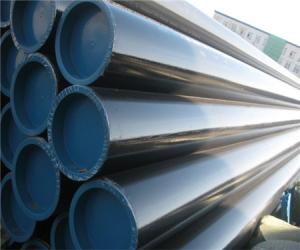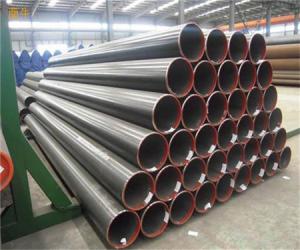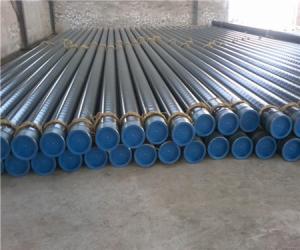Welded Stainless Steel Tube/Pipe Manufacturer
- Loading Port:
- China Main Port
- Payment Terms:
- TT or LC
- Min Order Qty:
- 30 kg
- Supply Capability:
- 12000 kg/month
OKorder Service Pledge
OKorder Financial Service
You Might Also Like
1、Structure of Seamless Pipe ASTM A106/53:
Seamless pipe is formed by drawing a solid billet over a piercing rod to create the hollow shell. As the manufacturing process does not include any welding, seamless pipes are perceived to be stronger and more reliable. Historically seamless pipe was regarded as withstanding pressure better than other types, and was often more easily available than welded pipe.
Application
carbon seamless steel pipes are widely used in gas, water and oil, transpotation;constructions;Bridge,highway,windows of model steel door; building materials;fences;heating facilities Fluid Pipe;conduit pipe,scaffolding pipe.etc.
Payment Terms: L/C D/A D/P T/T
Packing and shipment
Packaged in bundles,as per customers' requirements, it can also bepackagesd as beveled ends, typed marking, black painting, plastic caps protection,woven bags packing
For 20" container the max length is 5.8m; For 40" container the max length is 12m. other options are available based on customer requests. Please discuss when placing orders.
2、Main Features of the Seamless Pipe ASTM A106/53:
• High manufacturing accuracy
• High strength
• Small inertia resistance
• Strong heat dissipation ability
• Good visual effect
• Reasonable price
3、Seamless Pipe ASTM A106/53 Specification:
Standard | GB, DIN, ASTM ASTM A106-2006, ASTM A53-2007 |
Grade | 10#-45#, 16Mn 10#, 20#, 45#, 16Mn |
Thickness | 8 - 33 mm |
Section Shape | Round |
Outer Diameter | 133 - 219 mm |
Place of Origin | Shandong, China (Mainland) |
Secondary Or Not | Non-secondary |
Application | Hydraulic Pipe |
Technique | Cold Drawn |
Certification | API |
Surface Treatment | factory state or painted black |
Special Pipe | API Pipe |
Alloy Or Not | Non-alloy |
Length | 5-12M |
Outer Diameter | 21.3-610mm |
Grade | 20#, 45#, Q345, API J55, API K55, API L80, API N80, API P110, A53B |
Standard | ASME, ASTM |
1) Material:20#(ASTM A 106/A53 GRB.API5LGRB,GB),45#,16Mn,10#.
2) Specification range:OD:21.3-610mm,WT:6-70mm,length:6-12m or according to the requirement of clients.
3) Excutive standards:GB,ASME API5L.ASTM A 106/A53,Despite of the above standards,we can also supply seamless steel pipe with standard of DIN,JIS,and so on,and also develop new products according to the requirements of our clients!
4) Surface:black lacquered,varnish coating or galvanized.
5) Ends:Beveled or square cut,plastic capped,painted.
6) Packing:bundles wrapped with strong steel strip,seaworthy packing.
4、Packaging & Delivery
Packaging Details: | seaworthy package,bundles wrapped with strong steel strip |
Delivery Detail: | 15-30days after received 30%TT |
5、FAQ of Seamless Pipe ASTM A106/53:
①How is the quality of your products?
Our products are manufactured strictly according to national and internaional standard, and we take a test
on every pipe before delivered out. If you want see our quality certifications and all kinds of testing report, please just ask us for it.
Guaranteed: If products’ quality don’t accord to discription as we give or the promise before you place order, we promise 100% refund.
②How about price?
Yes, we are factory and be able to give you lowest price below market one, and we have a policy that “ for saving time and absolutely honest business attitude, we quote as lowest as possible for any customer, and discount can be given according to quantity”,if you like bargain and factory price is not low enough as you think, just don’t waste your time.Please trust the quotation we would give you, it is professional one.
③Why should you chose us?
Chose happens because of quality, then price, We can give you both.Additionally, we can also offer professional products inquiry, products knowledge train(for agents), smooth goods delivery, exellent customer solution proposals.Our service formula: good quality+good price+good service=customer’s trust
SGS test is available, customer inspection before shipping is welcome, third party inspection is no problem.
6、Seamless Pipe ASTM A106/53 Images:
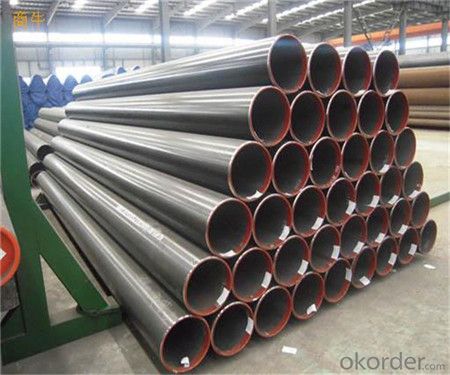
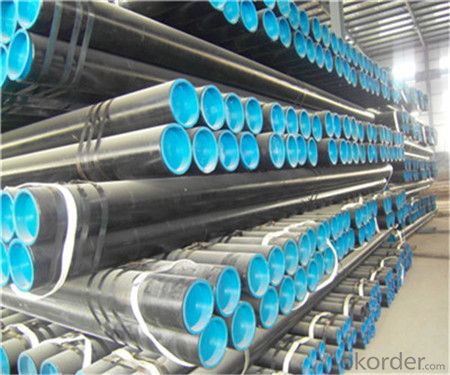
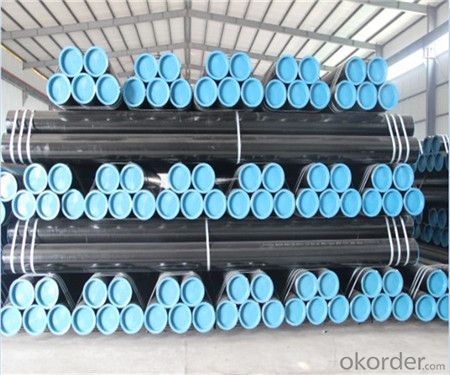
- Q:How do you prevent noise transmission in stainless steel pipes?
- There are several effective methods to prevent noise transmission in stainless steel pipes. 1. Insulation: One of the most common and effective ways to prevent noise transmission is by insulating the stainless steel pipes. Insulation materials such as mineral wool, fiberglass, or foam can be wrapped around the pipe to absorb and dampen sound waves. This helps to reduce the noise transmitted through the pipes. 2. Vibration isolation: Noise transmission can also be reduced by using vibration isolation techniques. This involves installing flexible connectors or rubber mounts between the pipe and its supports. These isolators absorb vibrations and prevent them from being transmitted as noise through the pipe. 3. Anti-vibration pads: Another method to prevent noise transmission is by using anti-vibration pads. These pads are placed under the pipe supports to absorb vibrations and prevent them from being transmitted as noise. They act as a barrier between the pipe and its support, reducing noise transmission significantly. 4. Acoustic lagging: Acoustic lagging is a technique that involves applying a noise-reducing material directly onto the surface of the stainless steel pipes. This material, often made of mass-loaded vinyl or rubber, acts as a barrier to block the transmission of sound waves. It effectively reduces noise transmission and can be used in combination with insulation for even better results. 5. Proper pipe routing: Noise transmission can be minimized by ensuring proper pipe routing. Pipes should be installed in a way that minimizes the amount of contact or proximity to other structures or surfaces that can amplify noise. Additionally, avoiding sharp bends or angles in the pipe can help reduce noise transmission. It is important to note that the choice of method may vary depending on the specific noise issue and environment. A professional acoustic consultant or engineer can provide guidance on the most suitable solution for a particular situation.
- Q:Can stainless steel pipes be insulated with cellulose?
- Indeed, it is possible to insulate stainless steel pipes with cellulose. Cellulose insulation is frequently selected to insulate pipes because of its exceptional thermal resistance and fire-resistant characteristics. It can be employed on a wide range of pipe materials, including stainless steel. There are various methods available for applying cellulose insulation to pipes, including using cellulose insulation blankets to wrap the pipes or filling the pipe cavities with loose-fill cellulose insulation. By insulating stainless steel pipes with cellulose, one can effectively prevent heat loss, decrease energy consumption, and maintain a consistent temperature within the pipes.
- Q:How do stainless steel pipes compare to titanium pipes?
- Stainless steel pipes are generally more cost-effective and readily available compared to titanium pipes. While both materials offer excellent corrosion resistance, titanium pipes have superior strength and durability. However, titanium pipes are significantly more expensive and may require specialized welding techniques. Ultimately, the choice between stainless steel and titanium pipes depends on the specific application and budget constraints.
- Q:What is the difference between 304Cb and 316Cb stainless steel pipes?
- The main difference between 304Cb and 316Cb stainless steel pipes lies in their chemical composition and their respective properties. 304Cb stainless steel is an austenitic stainless steel alloy that contains chromium and nickel. It also has a small amount of niobium, which enhances its resistance to intergranular corrosion. This makes 304Cb stainless steel pipes suitable for a wide range of applications, including food processing, chemical and petrochemical industries, and architectural purposes. On the other hand, 316Cb stainless steel is also an austenitic stainless steel alloy that contains chromium and nickel. However, it has a higher percentage of molybdenum, which gives it superior resistance to corrosion and pitting in chloride environments. This makes 316Cb stainless steel pipes ideal for applications where exposure to saltwater or other corrosive substances is common, such as marine environments or coastal areas. In summary, while both 304Cb and 316Cb stainless steel pipes are excellent choices for various applications, 316Cb stainless steel offers better corrosion resistance in chloride environments due to its higher molybdenum content. Depending on the specific needs and environment of the application, one may be more suitable than the other.
- Q:Can stainless steel pipes be used for underground drainage systems?
- Yes, stainless steel pipes can be used for underground drainage systems. Stainless steel is a durable and corrosion-resistant material that can withstand the harsh conditions often found underground, such as moisture, soil chemicals, and varying temperatures. It is also resistant to rust, which is a common problem in other types of pipes. Additionally, stainless steel pipes have a long lifespan and require minimal maintenance, making them a suitable choice for underground drainage systems.
- Q:Can stainless steel pipes be used for air conditioning systems?
- Yes, stainless steel pipes can be used for air conditioning systems. Stainless steel is known for its corrosion resistance, durability, and ability to handle high temperatures, making it a suitable material for air conditioning systems. It helps maintain the quality of air and prevents contamination due to its non-reactive nature. Additionally, stainless steel pipes offer excellent mechanical strength and are resistant to damage caused by external factors such as moisture or chemicals.
- Q:Are stainless steel pipes suitable for power plant systems?
- Yes, stainless steel pipes are suitable for power plant systems. Stainless steel is known for its excellent corrosion resistance, which is crucial in power plant systems where pipes are exposed to high temperatures, pressure, and various corrosive elements such as water, steam, and chemicals. Stainless steel pipes are highly resistant to rust, oxidation, and scaling, ensuring long-term reliability and durability in power plant operations. Additionally, stainless steel pipes have high strength and are able to withstand the high pressure and stress that power plant systems may experience. They also have excellent heat resistance, which is important in power plants where pipes are exposed to extreme temperatures. Overall, stainless steel pipes are a popular choice in power plant systems due to their corrosion resistance, strength, and heat resistance properties.
- Q:Are stainless steel pipes recyclable?
- Yes, stainless steel pipes are recyclable. Stainless steel is a highly sustainable material that can be recycled indefinitely without losing its properties. Stainless steel pipes can be melted down and transformed into new stainless steel products, making them a valuable resource in the recycling industry. The recycling process for stainless steel pipes involves collecting and sorting the pipes, melting them down in a furnace, and then forming them into new products. Recycling stainless steel pipes not only conserves natural resources but also reduces energy consumption and greenhouse gas emissions associated with the production of new stainless steel.
- Q:Can stainless steel pipes be insulated with polyethylene terephthalate?
- No, stainless steel pipes cannot be insulated with polyethylene terephthalate. Polyethylene terephthalate is not suitable for insulating stainless steel pipes due to its lower heat resistance and poor compatibility with metal surfaces.
- Q:Classification, advantages and disadvantages of stainless steel welding
- Metal gas shielded arc welding.It belongs to the gas protection welding, also is a kind of arc welding, that is, in the protection of gas, welding rod arc melting. Metal gas welding can be used in steel, non alloy steel, low-alloy steel and high alloy, etc. these materials are widely used. But one thing, its protective gas must be an active gas, such as carbon dioxide or a mixture of gases. The only drawback is that if the outdoor welding, then the workpiece can not be damp, otherwise it will affect the protection of gas protection effect.
1. Manufacturer Overview |
|
|---|---|
| Location | |
| Year Established | |
| Annual Output Value | |
| Main Markets | |
| Company Certifications | |
2. Manufacturer Certificates |
|
|---|---|
| a) Certification Name | |
| Range | |
| Reference | |
| Validity Period | |
3. Manufacturer Capability |
|
|---|---|
| a)Trade Capacity | |
| Nearest Port | |
| Export Percentage | |
| No.of Employees in Trade Department | |
| Language Spoken: | |
| b)Factory Information | |
| Factory Size: | |
| No. of Production Lines | |
| Contract Manufacturing | |
| Product Price Range | |
Send your message to us
Welded Stainless Steel Tube/Pipe Manufacturer
- Loading Port:
- China Main Port
- Payment Terms:
- TT or LC
- Min Order Qty:
- 30 kg
- Supply Capability:
- 12000 kg/month
OKorder Service Pledge
OKorder Financial Service
Similar products
New products
Hot products
Hot Searches
Related keywords

